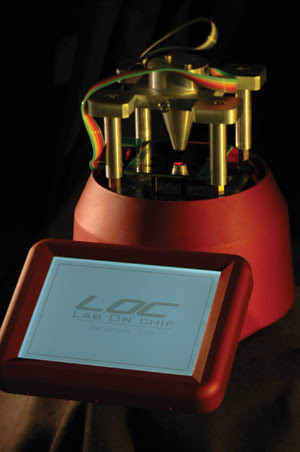
Handheld sensor could become a big hit on the battlefield
David L. Shenkenberg
At the Institute of Microelectronics in Singapore, Pavel Neuzil and Julien Reboud have developed a palm-size sensor to detect pathogens and toxins that does not require an external power supply or a PC. Instead, it uses a simple rechargeable 12-V battery and a single computer chip.

This simple handheld sensor uses surface plasmon resonance to analyze samples.
The researchers believe that it represents a generation of simpler sensors. Its portability lends itself to point-of-care and field applications such as treating soldiers abroad.
The device has a scan head that contains just four LEDs and a simple detector called a photodiode. The LED light travels down conduits in the scan head and hits the sample under investigation, and the reflected light from the sample in the chip travels back through another conduit, leading to the photodiode, in the center of the scan head.
The investigators used 660-, 627-, 588- and 525-nm LEDs. Only one is required for measurement, but using more improves the resolution.
The sample is placed on a small polymer chip coated with an infinitesimal layer of gold particles. The way that the LED light interacts with the sample and the gold particles changes the amount of light absorbed at the spectral peak; consequently, less light is reflected into the detector. This is an existing spectroscopy technique called localized surface plasmon resonance.
One advantage of using the resonance technique is that it does not require fluorescent dyes or other labels: Just wash the sample over the sensor, turn on the light, and take a reading. The chip and the unit housing the scan head are connected to a touch-screen LCD that provides a useful interface.
The researchers tested the instrument by washing solutions of ethanol and isopropyl alcohol in water over the chip. They showed that the device could discriminate between the alcohol solutions.
Neuzil said that, in the future, the gold surface of the chip could have bound antigens against the infectious organism believed to be in a patient’s system. A fluid sample such as blood could be washed over the antigens on the chip, which would lead to a detectable signal.
He said that frequent discussion with doctors, biologists and other professionals will lead to improvements in features of the device for real-world applications. He added that the chip could be integrated with a microfluidic system to increase throughput.
Analytical Chemistry, Aug. 1, 2008, pp. 6100-6103.
Published: September 2008